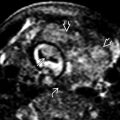KEY FACTS
Terminology
- •
Mechanisms of injury
- ○
Overuse: Strenuous exercise results in diffuse muscular edema
- ○
Stretch: Causes torn muscle fibers + hematoma
- ○
Direct: Usually blunt trauma causes contusion, ± hematoma, ± tear
- ○
Imaging
- •
Delayed-onset muscle soreness
- ○
Overuse leads to diffuse muscular edema
- ○
Muscle may appear normal or diffusely hyperechoic
- ○
- •
Muscle contusion/hematoma
- ○
Contusion: Ill-defined echogenic muscle; dispersed form of hematoma
- ○
Hematoma: Focal hemorrhage often associated with tear
- ○
- •
Muscle or myofascial tear
- ○
Usually partial at/near myofascial junction
- ○
Discontinuity ± retraction of fibers filled with hematoma (hematoma can obscure)
- ○
- •
Muscle hernia
- ○
Focal protrusion of fibers through investing fascia
- ○
Accentuated by contraction or standing
- ○
Clinical Issues
- •
Tears occur at common locations from common mechanisms
- •
Most injuries improve with conservative treatment and do not require follow-up ultrasound
- •
Clinical symptoms overlap with other diagnoses seen with ultrasound (deep vein thrombosis, tendinosis)
Scanning Tips
- •
Use contralateral side for comparison; even if bilateral, abnormalities often appear asymmetric
- •
Carefully assess distal medial gastrocnemius for small tears
- •
Use active contraction/passive joint movement to show retraction of fibers
 consistent with delayed-onset muscle soreness. The overlying biceps muscle
consistent with delayed-onset muscle soreness. The overlying biceps muscle  and humeral shaft
and humeral shaft  are normal.
are normal.
 at the myofascial junction
at the myofascial junction  with the soleus muscle
with the soleus muscle  . The retraction gap is filled with blood.
. The retraction gap is filled with blood.
Stay updated, free articles. Join our Telegram channel

Full access? Get Clinical Tree








